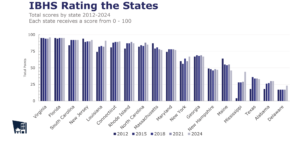At the outset of the coronavirus pandemic last year, some insurance industry analysts predicted that the crisis and its economic ramifications would slow mergers and acquisitions in the P/C market as carriers shifted their focus toward ensuring business continuity.
But a faster-than-expected economic rebound and carriers’ growing realization that the new normal demanded an acceleration of digital innovation—which often requires a level of investment and growth that M&As are uniquely suited to help achieve—have defied those predictions.
A third-quarter surge in M&A activity and blockbuster deals like KKR’s $4.7 billion acquisition of Global Atlantic Financial Group Limited—announced last July and closed this month—are pointing in a very different direction. S&P Global points to a range of factors that could “provide new urgency” for M&As as the business climate pushes carriers toward new deals that can unlock new value and enhance operational efficiency.
P/C deals are slated to be at the forefront of this activity, given that those businesses have proven more lucrative than life insurance over the past decade, as a recent McKinsey & Company analysis notes.
Meanwhile, as the ongoing pandemic reinforces consumers’ growing reliance on digital technology to live, work and shop, customer patience for subpar digital experiences—already exceedingly thin—will only continue to fade. Acquiring carriers with robust digital capabilities can be an effective way for carriers to meet mounting customer expectations for seamless experiences, both online and offline.
From the implementation of new business models to improved resilience in the face of growing competition, M&As will provide more and more P/C carriers with a viable pathway to meeting the imperatives of a rapidly evolving industry landscape.
The Need for Consolidation
Consolidation is typically seen as inimical to competition—and as detrimental to innovation. And while the annals of business history feature plenty of case studies to support this view, M&As have a vital role to play in making the insurance industry more vibrant, more innovative and more customer centric.
The rise of InsurTechs has compelled legacy players to step up their innovation game and invest in new offerings designed to meet the needs of today’s digitally savvy consumers and go toe-to-toe with digital-first insurers.
When legacy companies join forces with each other or even with InsurTech startups, they can expand their product offerings, enhance the services they provide customers and spur more competitive innovation across the industry.
Gauging the Impact
How will these changes play out in practice?
One of the biggest benefits of achieving the level of technological prowess that M&As can provide is that it empowers insurers to deliver tailored policies that dynamically reflect each customer’s unique needs and behavior. In an economy where personalization is now a basic customer expectation, that’s a formidable advantage.
Of course, customer behavior has changed dramatically amid the past year’s pandemic restrictions, which is why more auto insurance consumers are expressing interest in models like “pay-as-you-drive” insurance, with rates and policies adjusted as policyholders change their driving habits.
Research from Accenture reveals that 69 percent of consumers would be willing to share the personal data required to customize policy premiums—a 19 percent jump from two years ago. As more consumers demand personalized, usage-based insurance policies, M&As can deliver the technological capabilities and synergies required to provide these services at scale.
As a PwC report on industry M&As noted, technology-focused deals should be considered from the perspectives of both “pro-active and defensive positions.”
In light of the InsurTech revolution, many legacy players are considering M&As from a primarily defensive position, seeking out deals that can help them stave off the threat posed by nimbler, more technologically advanced rivals.
But carriers should also take a longer view when it comes to which deals to pursue—a view rooted not exclusively in reaction to emerging threats but in a deep understanding of how trends like personalization, data analytics, artificial intelligence and more are reshaping the future of the customer experience across industries. Deals that reflect a firm grasp of these trends will be most conducive to innovation and long-term success.
The past year has provided ample evidence that the world is being radically disrupted by forces both foreseen (growing digitization and automation) and unforeseen (historic crises that have sharply accelerated predicted trends while also creating entirely new challenges, risks and opportunities).
And while the sheer range and scale of these disruptions can make it difficult to predict what the future holds, one thing is abundantly clear for P/C insurers seeking to make sense of it all: Future success will depend on their ability to serve high-quality, personalized customer experiences, bring to bear the most valuable technologies and respond rapidly to the needs of an ever-changing world. That’s precisely why 2021 will feature even more M&A activity.





















 Study: Average Cyber Breach Insurance Coverage Gap is 350%
Study: Average Cyber Breach Insurance Coverage Gap is 350%  P/C Insurance Execs, Underwriters Out of Sync on Advanced Tech
P/C Insurance Execs, Underwriters Out of Sync on Advanced Tech  USAA to Lay Off 220 Employees
USAA to Lay Off 220 Employees  Study: U.S. Companies Facing Class Actions at Highest Level in 13 Years
Study: U.S. Companies Facing Class Actions at Highest Level in 13 Years 







